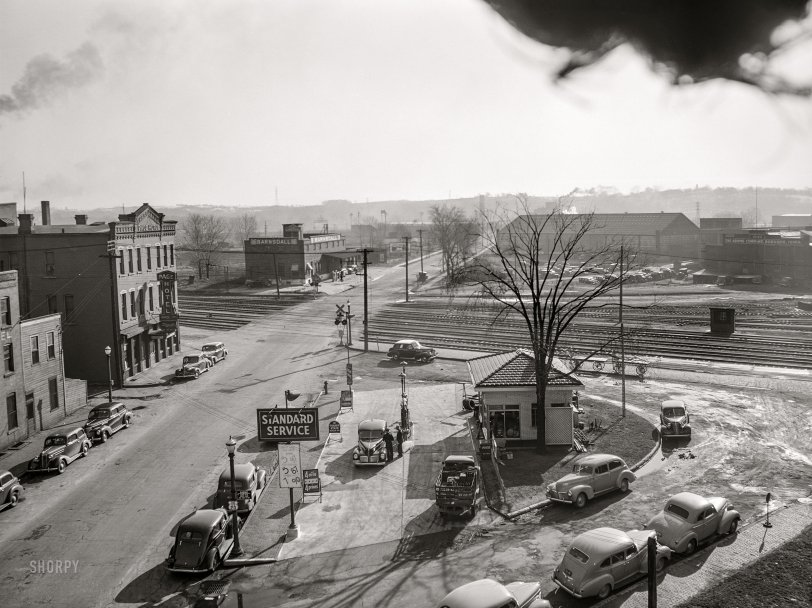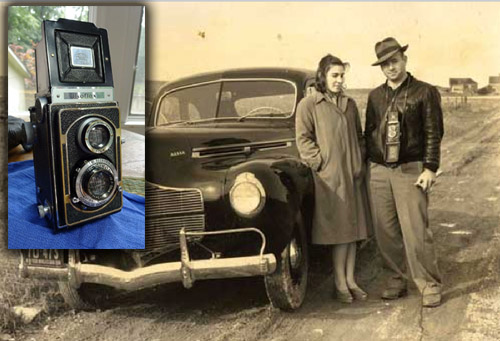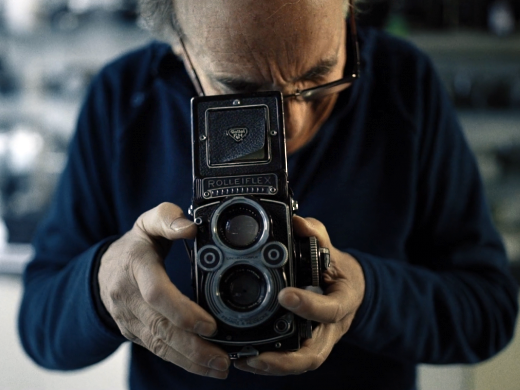


Framed or unframed, desk size to sofa size, printed by us in Arizona and Alabama since 2007. Explore now.
Shorpy is funded by you. Patreon contributors get an ad-free experience.
Learn more.

- Lofty addition
- In 1912
- Keenan Building
- Six years old
- Taken from the P.J. McArdle Roadway?
- It stood only 47 years
- Three track mind
- Incline to the right
- Reach for the sky, 1912 style
- No clean sweep
- Same Job Title, Same Face
- Sadly Lost
- Beautiful ...
- Where you get your kicks
- Aim High
- Pueblo Revival sisters
- Pueblo Neoclassicism
- Milk Man
- Regional dialect.
- Spielberg's inspiration
- Great Photo
- Loaf Story
- Do you still have the Rakes category?
- Could almost be a scene from the 1957 movie 'Hell Drivers'
- The Wages of Fear.
- Conspicuous by their absence
- Got Milk?
- All that aluminum
- No lefties
- Smoke 'em if you've got 'em
Print Emporium
Standard Service: 1940

April 1940. "Gas station on a sunny afternoon. Dubuque, Iowa." Medium format acetate negative by John Vachon for the Resettlement Administration. View full size.
There was a fire here, too
The six-story brick building shown in the "Current View" post is the Canfield Hotel, built in 1927 as an addition to the existing four-story wooden structure. In 1946 a fire destroyed the older wooden building, killing 19 people, including owner William Canfield. The picture would have been taken from the four-story wooden part. An account of the fire:
http://www.encyclopediadubuque.org/index.php?title=CANFIELD_HOTEL
Photographer's viewpoint
Well, we can see where the photo was taken from in radiochris's modern shot.
Gas Prices
What's up with the sign? Prices? Octanes?
[Yes. - Dave]

Double vision
Unlike commenter Jim Page, I'm a newcomer to twin-lens reflex cameras, having started to collect them last year. I found this image of Jack Delano somewhere in cyberspace. I believe that's a Zeiss Ikon Ikoflex around his neck. Being a serious fan, I just had had to buy one.

If you build it they will come
It's kind of hard to see but if you follow the road (4th Street) from the bottom towards the top of the picture you will see a baseball stadium in the distance. It was known alternatively as Municipal Stadium, 4th Street Stadium, or John Petrakis Park. It was built in 1915 and was razed sometime in the 1970s, I believe. It hosted several minor league ballclubs.
John Vachon
John Vachon's FSA pictures are sadly underrated. He was highly influenced by Walker Evans, whose plain and unpretentious portraits showed little evidence of advocacy or drama. Vachon had the same style, but his subject matter often differed from that of Evans. Vachon was young and inexperienced when he was hired by FSA head Roy Stryker. He fell in love with the camera, and loved touring the country for the first time. He photographed just about everything he saw, in this case a gas station near the railroad tracks. Consequently, his vast collection of pictures has become a valuable document of how life and the built environment looked in the 1930s.
Heavy metal
Being a steam locomotive fanatic, I would want a room facing the tracks in the hotel. Unfortunately I wouldn't be born until Nov. of 1940. Looks like a busy crossing and with the baggage carts must be right at the depot.
U.S. 61 Freeway There Now
Based on this article, the Page Hotel stood at Fourth and White Streets, about where the U.S. 61 freeway is now.
http://www.encyclopediadubuque.org/index.php?title=PAGE,_John
Current view?
The Page Hotel, located in the upper left, was located at the corner of Fourth and White streets. This view from Google Maps, appears to show approximately the same view. Not sure if the existing brick building across the tracks is the same one in the current view.

That does double for me!
I loved all my twin-lens reflex cameras and wish I had kept them. But nnnnoooooo ...
Hairy Cat
Considering the Cat's hair in this self-portrait (https://www.shorpy.com/node/25187), I wonder if Mr. Vachon was peering over the camera and looking at the lens (or out the window) the moment this exposure happened.
[He was looking down into the viewfinder. - Dave]

























On Shorpy:
Today’s Top 5